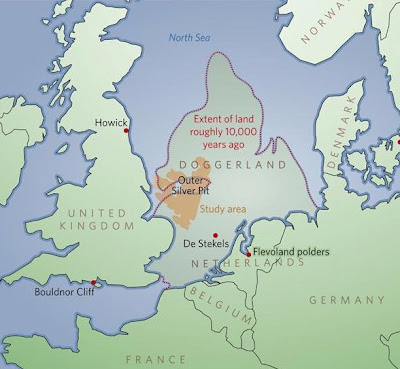
New geological evidence of a massive cataclysm engulfing the earth about 12,000 years ago has been found in the American Midwest. The discovery of diamonds, gold and silver at sites throughout Ohio and Indiana – though the materials originated in Canada – point to a massive explosion precipitated by a comet or asteroid striking the earth with devastating results.
As anyone who has read my post Why I Started this Blog is aware, I’m greatly intrigued by the possibility that a worldwide cataclysm occurred such a relatively short time ago. Proponents contend that such an event demolished previous civilizations, drove countless plant and animal species to extinction, and drastically changed the topographical nature of the planet. The cataclysm may be the origin of stories such as the biblical Noah’s flood that are found across the ancient writings of several cultures that presumably had no contact with each other.
Explosion Scatters Canadian Diamonds
The possibility of such a cataclysm was once again advanced in 2007 by geophysicist Allen West of Arizona, who contends a comet or asteroid – likely at least a mile in diameter – exploded above a region of Canada, setting fire to most of the northern hemisphere and causing severe climatic cooling that lasted 1,000 years. West believes the diamonds, gold, silver and other minerals were blown from Canada's diamond-bearing fields to areas around much of the northern hemisphere. His research team in 2007 found the minerals in 26 sites in North America and Europe and were able to determine that they originated from the same location in Canada.
Now microscopic bits of diamond, gold and silver have been unearthed in various parts of Ohio and Indiana. Anthropologist Ken Tankersley of the University of Cincinnati recovered the minerals, which were conclusively sourced back to the specific area of Canada by the university’s geologists using X-ray diffractometry.
“We believe this is the strongest evidence yet indicating a comet impact in that time period,” Tankersley said in a press release issued by the university. The diamonds and other minerals originating in Canada are being found at a subsurface depth consistent with West’s timing of the comet, thus ruling out the earlier belief that they could have been carried southward by glaciers.
The possibility of such a cataclysm was once again advanced in 2007 by geophysicist Allen West of Arizona, who contends a comet or asteroid – likely at least a mile in diameter – exploded above a region of Canada, setting fire to most of the northern hemisphere and causing severe climatic cooling that lasted 1,000 years. West believes the diamonds, gold, silver and other minerals were blown from Canada's diamond-bearing fields to areas around much of the northern hemisphere. His research team in 2007 found the minerals in 26 sites in North America and Europe and were able to determine that they originated from the same location in Canada.
Now microscopic bits of diamond, gold and silver have been unearthed in various parts of Ohio and Indiana. Anthropologist Ken Tankersley of the University of Cincinnati recovered the minerals, which were conclusively sourced back to the specific area of Canada by the university’s geologists using X-ray diffractometry.
“We believe this is the strongest evidence yet indicating a comet impact in that time period,” Tankersley said in a press release issued by the university. The diamonds and other minerals originating in Canada are being found at a subsurface depth consistent with West’s timing of the comet, thus ruling out the earlier belief that they could have been carried southward by glaciers.
More Support for Revised History
In my earlier post, I wrote about the book Cataclysm!: Compelling Evidence of a Cosmic Catastrophe in 9500 B.C, by D.S. Allan and J.B. Delair. They contend that about 11,500 years ago (or 9500 B.C.) our solar system was invaded by pieces of a supernova, or exploding star. The path of a couple of the largest pieces disrupted our solar system, dislodged some planets from their previous orbits, scattered several planetary moons and demolished one entire planet. Earth was knocked off its previous poles, setting off an enormous cataclysm, changing our planet in major ways and nearly extinguishing mankind.
Civilizations – likely including the mysterious Atlantis – were destroyed around the globe. The few human survivors sometimes banded together to create new civilizations, such as the ancient Egyptian and Mayan cultures, but more often were forced into a Stone Age existence.
The premise also is shared by noted author Graham Hancock in his popular books such as Fingerprints of the Gods.
As more evidence mounts to confirm the cataclysm theory, much of our archaeological, historical and scientific knowledge and text will be in serious need of updating, to say the least.












